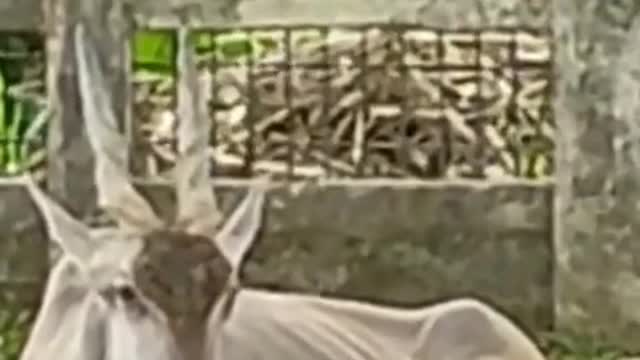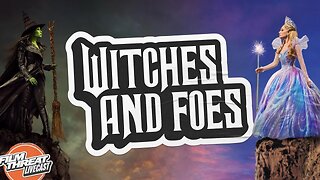Premium Only Content

A crow disturbing a cool eland.
The domestic donkey is a hoofed mammal in the family Equidae, the same family as the horse. It derives from the African wild ass, Equus africanus, and may be classified either as a subspecies thereof, Equus africanus asinus, or as a separate species, Equus asinus.[1]: 1 It was domesticated in Africa, probably about 5,000[1]: 2 or 6,000[2]: 3715 years ago, and has been used mainly as a working animal since that time.
Donkey
Conservation status
Domesticated
Scientific classificationKingdom:AnimaliaPhylum:ChordataClass:MammaliaOrder:PerissodactylaFamily:EquidaeGenus:EquusSpecies:
E. africanus
Subspecies:
E. a. asinus
Trinomial nameEquus africanus asinus
Linnaeus, 1758
Donkeys, feral, horse world distribution
There are more than 40 million donkeys in the world, mostly in underdeveloped countries, where they are used principally as draught or pack animals. While working donkeys are often associated with those living at or below subsistence, small numbers of donkeys or asses are kept for breeding or as pets in developed countries.
A male donkey is known as a jack or jackass, a female is a jenny or jennet,[3][4][5] and an immature donkey of either sex is a foal.[5] Jacks are often mated with mares to produce mules; the biological reciprocal of a mule, from a stallion and jenny, is a hinny.
The giant eland (Taurotragus derbianus), also known as the Lord Derby eland, is an open-forest and savanna antelope. A species of the family Bovidae and genus Taurotragus, it was described in 1847 by John Edward Gray. The giant eland is the largest species of antelope, with a body length ranging from 220–290 cm (86.5–114 in). There are two subspecies: T. d. derbianus and T. d. gigas.
Giant elandT. d. derbianus
SenegalT. d. gigas at the Cincinnati Zoo
Conservation status

Vulnerable (IUCN 3.1)[1]
Scientific classificationKingdom:AnimaliaPhylum:ChordataClass:MammaliaOrder:ArtiodactylaFamily:BovidaeSubfamily:BovinaeGenus:TaurotragusSpecies:
T. derbianus
Binomial nameTaurotragus derbianus
(J.E. Gray, 1847)
Subspecies
T. d. derbianus
T. d. gigas
Distribution of giant eland subspecies : Western giant eland
Eastern giant elandSynonyms
Species synonymy[2]
Tragelaphus derbianus (J.E. Gray, 1847)
Boselaphus derbianus J.E. Gray, 1847
Tragelaphus colini (de Rochebrune, 1883)
Tragelaphus typicus Rowland Ward, 1910
Tragelaphus gigas (Heuglin, 1863)
Tragelaphus cameroonensis Millais, 1924
Tragelaphus congolanus W. Rothschild, 1913
Tragelaphus derbii (Johnston, 1884)
The giant eland is a herbivore, eating grasses, foliage and branches. They usually form small herds consisting of 15–25 members, both males and females. Giant elands are not territorial, and have large home ranges. They are naturally alert and wary, which makes them difficult to approach and observe. They can run at up to 70 km/h (43 mph) and use this speed as a defence against predators. Mating occurs throughout the year but peaks in the wet season. They mostly inhabit broad-leafed savannas, woodlands and glades.
The giant eland is native to Cameroon, Central African Republic, Chad, Democratic Republic of the Congo, Guinea, Mali, Senegal, and South Sudan. It is no longer present in The Gambia, Ghana, Ivory Coast, and Togo. It can also be found in the Jos wildlife park in Nigeria, Guinea-Bissau, and Uganda due to over hunting and a lack of professional wildlife management. The subspecies have been listed with different conservation statuses by the International Union for Conservation of Nature (IUCN)
-
 LIVE
LIVE
Lara Logan
3 hours agoSTOLEN ELECTIONS with Gary Berntsen & Ralph Pezzullo | Ep 45 | Going Rogue with Lara Logan
353 watching -
 1:47:18
1:47:18
Steven Crowder
4 hours agoTo Execute or Not to Execute: Trump Flips the Dems Sedition Playbook Back at Them
246K242 -
 16:11
16:11
RealMetatron
19 hours agoHasan Piker got HUMBLED in New York
7.43K4 -
 LIVE
LIVE
Viss
3 hours ago🔴LIVE - Helping Those That Need It Today - Arc Raiders!
145 watching -
 43:37
43:37
The Rubin Report
3 hours agoTriggernometry Hosts Try to Hide Their Shock at Sam Harris’ Charlie Kirk Claim
29.7K28 -
 LIVE
LIVE
SOLTEKGG
1 hour ago🟢 Live: Pro Player Returns to Battlefield 6 RED SEC
36 watching -
 LIVE
LIVE
StevieTLIVE
3 hours agoFriday Warzone HYPE: Come Chill, Chat, and Watch Me Fry
29 watching -
 1:00:57
1:00:57
Dr. Eric Berg
3 days agoThe Dr. Berg Show LIVE - November 21, 2025
19.9K9 -
 LIVE
LIVE
Film Threat
19 hours agoWICKED FOR GOOD + SISU 2 + LOADS OF REVIEWS! | Film Threat Livecast
76 watching -
 1:39:56
1:39:56
The Mel K Show
3 hours agoMORNINGS WITH MEL K - Globalists Continue to Pursue Agenda 2030-While Americans are Being Easily Distracted 11-21-25
18.5K4